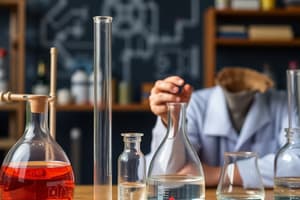Podcast
Questions and Answers
Explain how skepticism and objectivity contribute to the reliability of scientific findings.
Explain how skepticism and objectivity contribute to the reliability of scientific findings.
Skepticism encourages questioning and critical evaluation of claims, while objectivity minimizes bias in data collection and interpretation. Together, they ensure that scientific findings are based on evidence rather than personal beliefs.
Differentiate between a scientific theory and a scientific law, providing an example of each.
Differentiate between a scientific theory and a scientific law, providing an example of each.
A scientific theory explains why a phenomenon occurs, while a scientific law describes what happens. For example, the theory of evolution explains the diversity of life, while the law of gravity describes the attraction between masses.
Describe a scenario where an initial hypothesis is not supported by experimental data. What are the next steps a scientist should take?
Describe a scenario where an initial hypothesis is not supported by experimental data. What are the next steps a scientist should take?
If the experimental data does not support the initial hypothesis, a scientist should re-evaluate their hypothesis, modify their experimental design, or formulate a new hypothesis based on the observed results. It may also be necessary to check for errors in the experimental procedure.
Explain how the principles of the scientific method can be applied to solve a real-world problem outside of a laboratory setting. Provide an example.
Explain how the principles of the scientific method can be applied to solve a real-world problem outside of a laboratory setting. Provide an example.
A researcher observes that plants grow taller in sunny locations compared to shady locations. Formulate a testable hypothesis based on this observation.
A researcher observes that plants grow taller in sunny locations compared to shady locations. Formulate a testable hypothesis based on this observation.
Why is it important for scientists to use a standardized system of measurement, such as the SI system, when conducting experiments and sharing their results?
Why is it important for scientists to use a standardized system of measurement, such as the SI system, when conducting experiments and sharing their results?
Describe how the field of applied science contributes to advancements in other areas such as technology or medicine.
Describe how the field of applied science contributes to advancements in other areas such as technology or medicine.
Explain how advancements in one branch of science, such as physics, can influence or contribute to progress in another branch, such as biology.
Explain how advancements in one branch of science, such as physics, can influence or contribute to progress in another branch, such as biology.
Explain how increasing the sample size in an experiment can affect the reliability of the results, and why this is important for drawing accurate conclusions.
Explain how increasing the sample size in an experiment can affect the reliability of the results, and why this is important for drawing accurate conclusions.
Describe the difference between random errors and systematic errors in data collection, and provide an example of each.
Describe the difference between random errors and systematic errors in data collection, and provide an example of each.
Explain why it is important to use control groups in scientific experiments. What specific purpose do they serve in interpreting the results?
Explain why it is important to use control groups in scientific experiments. What specific purpose do they serve in interpreting the results?
How does the process of peer review contribute to the quality and validity of scientific publications?
How does the process of peer review contribute to the quality and validity of scientific publications?
Describe what 'informed consent' means in the context of research involving human subjects, and explain why it is ethically important.
Describe what 'informed consent' means in the context of research involving human subjects, and explain why it is ethically important.
Explain how advancements in computer technology have transformed scientific research, providing specific examples of their impact.
Explain how advancements in computer technology have transformed scientific research, providing specific examples of their impact.
Describe what plagiarism is in scientific writing, and why is it considered a form of scientific misconduct?
Describe what plagiarism is in scientific writing, and why is it considered a form of scientific misconduct?
Explain the role of inferential statistics in scientific data analysis. How do they help researchers draw conclusions from a sample about a larger population?
Explain the role of inferential statistics in scientific data analysis. How do they help researchers draw conclusions from a sample about a larger population?
Describe the relationship between scientific knowledge and public policy. How can scientific findings inform and influence decision-making in areas such as environmental regulations or public health initiatives?
Describe the relationship between scientific knowledge and public policy. How can scientific findings inform and influence decision-making in areas such as environmental regulations or public health initiatives?
How does replication of experiments contribute to the scientific process? Explain why repeating an experiment is essential for validating scientific findings.
How does replication of experiments contribute to the scientific process? Explain why repeating an experiment is essential for validating scientific findings.
Flashcards
What is Science?
What is Science?
A systematic and organized approach to understanding the natural world through observation, experimentation, and testable explanations.
What is Empirical Evidence?
What is Empirical Evidence?
Evidence based on observations and experiments.
What is the Scientific Method?
What is the Scientific Method?
A process for gaining knowledge using observation, hypothesis, experimentation, and analysis.
What is a Hypothesis?
What is a Hypothesis?
Signup and view all the flashcards
What are the Branches of Science?
What are the Branches of Science?
Signup and view all the flashcards
What is a Scientific Theory?
What is a Scientific Theory?
Signup and view all the flashcards
What is a Scientific Law?
What is a Scientific Law?
Signup and view all the flashcards
What is Measurement?
What is Measurement?
Signup and view all the flashcards
SI Units
SI Units
Signup and view all the flashcards
Derived Units
Derived Units
Signup and view all the flashcards
Controlled Experiment
Controlled Experiment
Signup and view all the flashcards
Control Group
Control Group
Signup and view all the flashcards
Descriptive Statistics
Descriptive Statistics
Signup and view all the flashcards
Inferential Statistics
Inferential Statistics
Signup and view all the flashcards
Graphs and Charts
Graphs and Charts
Signup and view all the flashcards
Peer Review
Peer Review
Signup and view all the flashcards
Scientific Integrity
Scientific Integrity
Signup and view all the flashcards
Misconduct in Science
Misconduct in Science
Signup and view all the flashcards
Study Notes
- Science represents a structured, methodical approach to deciphering the natural world.
- Science integrates observation, experimentation, and the formulation of testable explanations or theories.
Core Principles
- Science depends on empirical evidence derived from observations and experiments.
- Objectivity is crucial for minimizing bias during both data collection and interpretation.
- Skepticism remains encouraged, as scientific claims are subject to revision based on new evidence.
- Science posits that the natural world adheres to definitive rules and patterns.
- Scientific knowledge remains provisional and open to change with emerging evidence.
Scientific Method
- The scientific method describes knowledge acquisition achieved through observation, experimentation, and hypothesis testing.
- Observation marks the initial step, necessitating meticulous and systematic data compilation.
- A hypothesis provides a testable explanation for a specific phenomenon.
- Experiments are designed to rigorously test hypotheses under controlled settings.
- Data analysis involves interpreting experimental results to derive conclusions.
- Hypotheses supported by data may evolve into a theory that offers a substantiated explanation of natural phenomena.
Branches of Science
- Natural sciences explore the physical world, encompassing biology, chemistry, physics, and earth science.
- Social sciences investigate human behavior and societies, including psychology, sociology, economics, and political science.
- Formal sciences utilize systems for knowledge generation, including logic, mathematics, and computer science.
- Applied sciences use scientific knowledge to address practical issues, like engineering, medicine, and agriculture.
Scientific Theories and Laws
- A scientific theory presents a detailed explanation of the natural world, built upon repeatedly confirmed facts through observation and experimentation.
- A scientific law describes an observable phenomenon or regularity in nature.
- Theories explain "why," while laws describe "what."
- Theories predict future events.
- Laws often manifest as mathematical equations.
Measurement and Units
- Measurement involves assigning numerical values to physical quantities.
- The International System of Units (SI) serves as science's standard measurement system.
- Key SI units include meter (m) for length, kilogram (kg) for mass, second (s) for time, ampere (A) for electric current, kelvin (K) for temperature, mole (mol) for amount of substance, and candela (cd) for luminous intensity.
- Derived units are combinations of SI units, like the newton (N) for force (kg⋅m/s²) and the joule (J) for energy (kg⋅m²/s²).
Experimental Design
- A controlled experiment entails manipulating an independent variable to observe its effects on a dependent variable.
- Control groups offer baselines for comparison by not receiving the tested treatment or manipulation.
- Bias is minimized through the random assignment of subjects into treatment and control groups.
- Sample size, representing the number of subjects in a study, impacts result reliability, with larger sizes increasing confidence.
- Replication, repeating experiments, confirms and strengthens confidence in findings.
Data Analysis and Interpretation
- Data analysis organizes, summarizes, and interprets data.
- Descriptive statistics summarize data via measures of central tendency (mean, median, mode) and variability (range, standard deviation).
- Inferential statistics facilitate population conclusions from samples using tests like t-tests, ANOVA, and regression analysis.
- Visualization tools include bar graphs, line graphs, scatter plots, and pie charts.
- Error analysis identifies and quantifies error sources in data, distinguishing between random and systematic errors.
Scientific Communication
- Research findings are communicated through peer-reviewed publications in journals.
- Peer review, conducted by field experts, ensures paper quality and validity before publication.
- Scientific conferences and presentations disseminate research findings.
- Scientific writing should maintain clarity, conciseness, and objectivity.
- Proper citations credit information sources.
Ethics in Science
- Scientific integrity is critical for maintaining public trust.
- Ethical considerations encompass honesty, objectivity, openness, and respect for intellectual property.
- Misconduct includes fabrication, falsification, and plagiarism.
- Informed consent is essential for human research, ensuring participant understanding of study risks and benefits.
- Animal research adheres to ethical guidelines promoting humane treatment.
Tools and Technology
- Science uses tools and technologies like microscopes, telescopes, spectrometers, and computers.
- Microscopes visualize small objects.
- Telescopes observe distant objects in space.
- Spectrometers analyze material composition.
- Computers are used for data analysis, modeling, and simulation.
- Technological advancements have significantly broadened scientific research capabilities.
Science and Society
- Science addresses global challenges like climate change, disease, and poverty.
- Scientific knowledge informs public policy.
- Science education drives scientific literacy and critical thinking.
- Public engagement fosters scientific understanding and promotes evidence-based decisions.
- Science raises ethical considerations, such as genetic engineering and AI, requiring careful consideration.
Studying That Suits You
Use AI to generate personalized quizzes and flashcards to suit your learning preferences.




